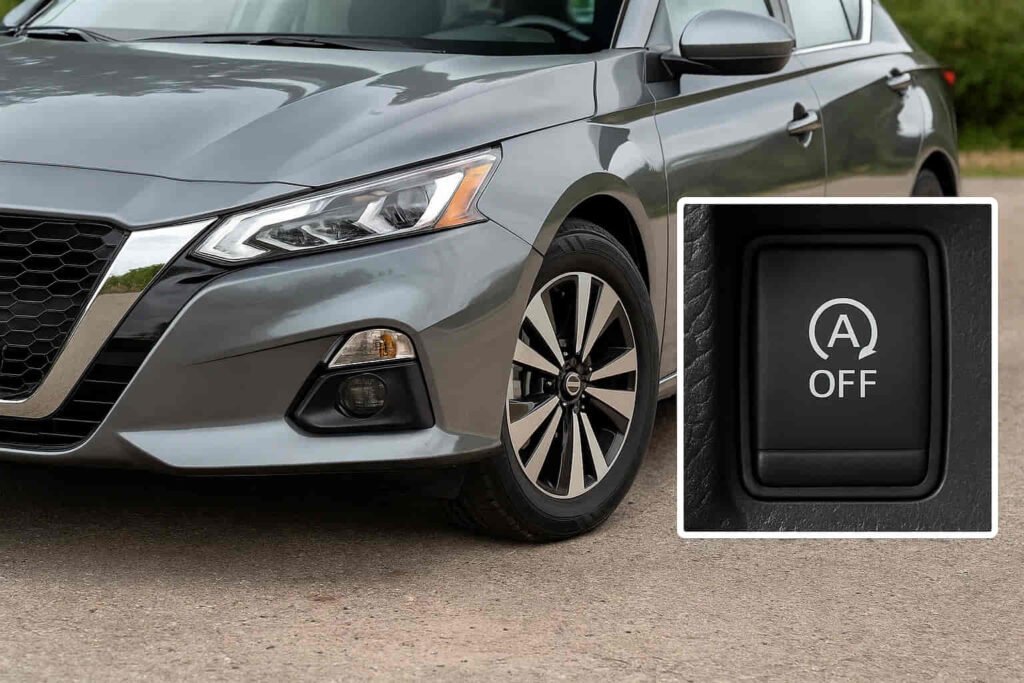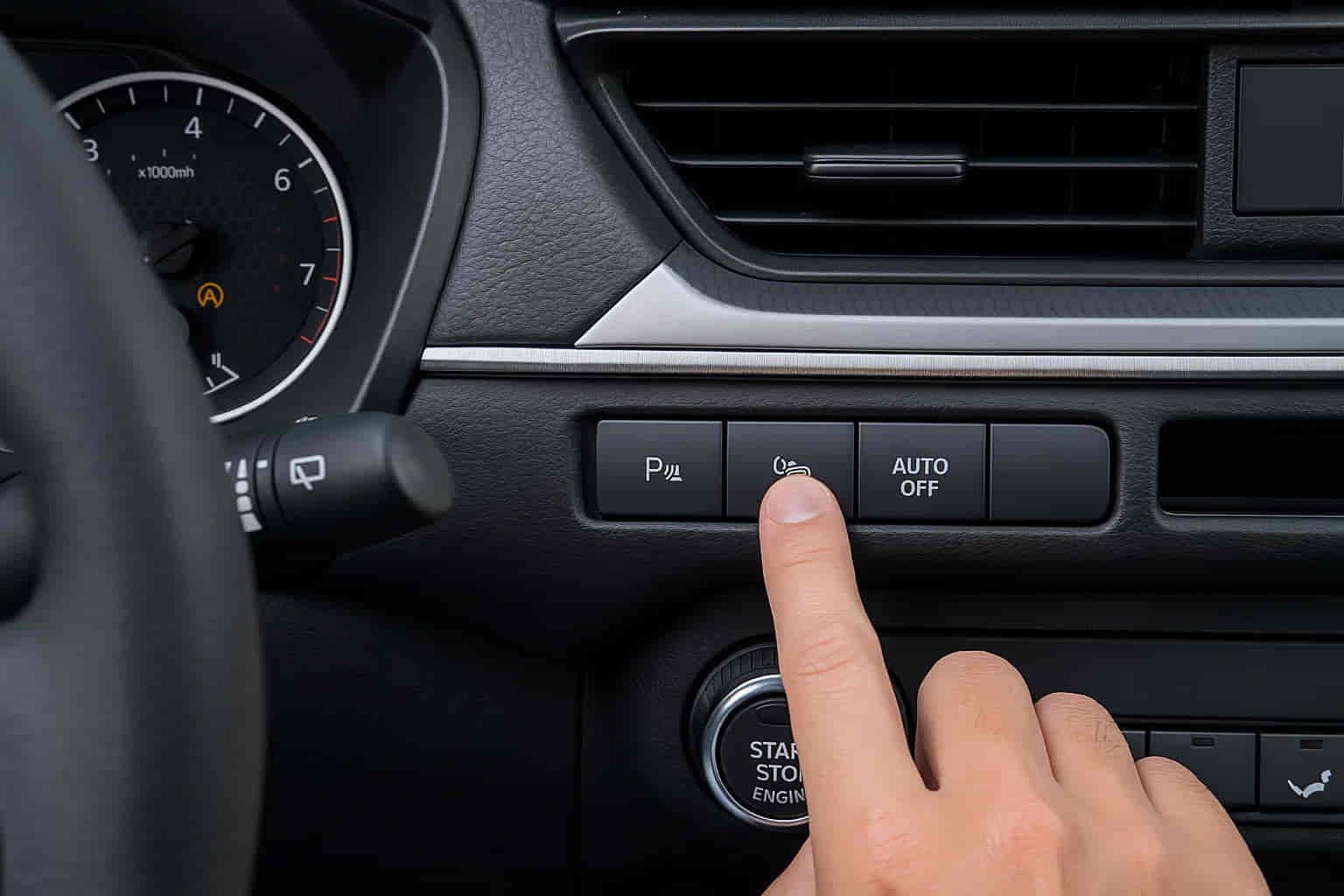If you drive a Nissan equipped with Auto Start-Stop technology, chances are you’ve experienced that brief moment of frustration when the engine shuts off at a red light, only to restart with a slight delay. While this system was designed to improve fuel efficiency and reduce emissions, many drivers find it inconvenient, disruptive, or even concerning for long-term engine health. The constant stop-and-go rhythm can feel unnatural, especially in heavy traffic, and questions often arise about whether the starter motor or battery might wear out faster.
For that reason, a growing number of Nissan owners are searching for how to permanently turn off Nissan Auto Start-Stop. But before making any changes, it’s important to understand both the safe methods available and the risks you should consider. Disabling this feature isn’t just about comfort—it also involves warranty implications, local regulations, and technical compatibility with your specific model.
In this step-by-step guide, we’ll explore the most reliable ways to permanently disable Nissan’s Auto Start-Stop system, discuss potential downsides, and help you choose the best solution for your vehicle. Whether you drive a Rogue, Altima, Pathfinder, or another Nissan model, this article will give you the clarity you need to make an informed decision.
What Is Nissan Auto Start-Stop and Why It Exists
Nissan Auto Start-Stop is a fuel-saving technology designed to switch off the engine when the vehicle comes to a complete stop and automatically restart it when the driver releases the brake. In theory, this small interruption reduces fuel consumption and lowers emissions during city driving, where traffic lights and congestion create countless moments of idling. Nissan introduced this system in line with global efficiency standards, positioning it as an eco-friendly innovation that contributes to lower carbon footprints without requiring drivers to change their habits.
The purpose of Auto Start-Stop is not only environmental but also economic. When the engine is off at a standstill, fuel that would otherwise be wasted simply burning at idle is conserved. Over time, especially in urban traffic, this can translate into measurable savings at the pump. Governments and regulatory bodies have encouraged automakers to integrate such systems as part of broader emission-reduction strategies.
However, while the reasoning behind Auto Start-Stop seems logical, many Nissan owners feel differently once they experience it daily. The momentary delay when the engine restarts can interrupt driving flow, and some worry about long-term wear on components such as the starter motor and battery. Instead of viewing it purely as a benefit, drivers often describe it as intrusive and unnecessary, particularly when comfort and reliability are valued over marginal fuel savings.
This tension between Nissan’s intention and driver experience explains why so many car owners look for information on how to permanently turn off Nissan Auto Start-Stop. Understanding why it exists helps put the debate into perspective—what was meant as progress for efficiency can become a frustration for those who prioritize smooth and predictable driving.
Risks of Turning Off Auto Start-Stop Permanently
When drivers begin searching for how to permanently turn off Nissan Auto Start-Stop, one of the most important considerations is the risk that comes with disabling the system. While the modification itself may seem straightforward, the consequences can be far more complex than simply switching off a feature you dislike.
The first issue revolves around warranty. Nissan, like most manufacturers, designs its vehicles with Auto Start-Stop as part of the original engineering. If you install aftermarket devices or attempt software modifications, you could potentially void certain aspects of your warranty, especially if a dealer determines that the change has influenced related components such as the ECU, starter motor, or battery. This risk alone is enough to make some owners hesitate, particularly those with newer models still under factory coverage.
Legal and regulatory concerns also play a role. Auto Start-Stop was introduced to help automakers meet emission targets, and in some regions, tampering with factory systems that reduce emissions could put you in violation of local regulations. While enforcement varies widely, the possibility should not be ignored, especially for drivers who live in areas with strict environmental laws.
Finally, there are mechanical considerations. Many Nissan owners worry about the impact of Auto Start-Stop on long-term engine health, but disabling the system improperly can create different kinds of strain. An unreliable reprogramming or low-quality memory module could cause electronic glitches, check-engine lights, or unexpected malfunctions that are more inconvenient than the original system itself.
For these reasons, turning off Auto Start-Stop permanently should never be approached lightly. Understanding the risks helps you make a more informed choice, balancing comfort against the potential downsides of modifying factory settings.
Step-by-Step Methods to Permanently Disable Nissan Auto Start-Stop

Using Auto Start-Stop Memory Module
One of the most popular and user-friendly ways to disable Nissan’s Auto Start-Stop system permanently is by installing an Auto Start-Stop memory module. This small electronic device is designed to “remember” the last setting of your vehicle’s start-stop button. Normally, when you restart your Nissan, the system automatically reactivates, forcing you to press the button every time if you prefer it off. With a memory module, the car recalls your preference, so if you turned the feature off once, it stays off every time you start the engine.
The installation process is typically plug-and-play. Most modules are designed specifically for Nissan models such as the Rogue, Altima, and Pathfinder, and they connect to the wiring behind the Auto Start-Stop switch. No advanced coding or ECU programming is required, which makes this solution attractive for owners who don’t want to risk major modifications. Many drivers also appreciate that the module can be removed later without leaving permanent traces, an important factor for warranty considerations.
The main advantage of this method is convenience. You don’t have to think about pressing the button repeatedly, and you avoid the technical risks associated with reprogramming the ECU. However, there is a cost involved, as these modules usually range from $60 to $150 depending on the brand. While it is one of the safest approaches, using a low-quality or incompatible device could still lead to glitches. For that reason, it is recommended to choose a reputable product designed for your exact Nissan model.
Using an OBD2 Device or Coding
Another effective method for drivers searching for how to permanently turn off Nissan Auto Start-Stop is through an OBD2 device or custom coding. OBD2 ports are standard diagnostic connectors located beneath the dashboard, and they provide direct communication with the car’s electronic control unit (ECU). By using a compatible device or software, owners can change the default Auto Start-Stop settings so that the system remains disabled whenever the engine is restarted.
The appeal of this approach lies in its simplicity. Many aftermarket OBD2 tools are plug-and-play, requiring no physical modifications to the vehicle’s wiring. Some devices even allow owners to toggle features through a mobile app, offering flexibility beyond Auto Start-Stop adjustments. Once coded, the system behaves as if it were designed to stay off permanently, giving drivers the smooth, uninterrupted driving experience they prefer.
However, OBD2-based solutions are not without drawbacks. In some cases, a dealer software update can reset the changes, requiring the process to be repeated. Additionally, poorly executed coding or the use of generic tools can cause software conflicts or trigger warning lights on the dashboard. This makes it crucial to select a trusted device or work with a specialist who understands Nissan’s ECU architecture.
Overall, OBD2 coding is a versatile option that avoids cutting wires or adding external modules, but it requires careful handling. For tech-savvy Nissan owners, it represents a powerful way to disable Auto Start-Stop permanently without relying on physical hardware.
Manual Button Hack
For Nissan owners who prefer a no-cost solution, the manual button hack is often the first option they try. Most Nissan vehicles equipped with Auto Start-Stop have a dedicated button on the dashboard that allows drivers to disable the feature temporarily. The problem, however, is that the system resets every time the car is restarted, forcing drivers to press the button again and again.
The so-called manual hack involves finding ways to trick the car into remembering the “off” state by default. Some drivers use simple workarounds, such as holding down the button for several seconds during startup, while others explore DIY wiring tweaks that keep the button in a disabled position. Although these methods are widely discussed on online forums, their effectiveness can vary depending on the Nissan model and year.
The biggest advantage of the manual approach is that it doesn’t require buying external devices or tampering with the ECU. It feels simple, direct, and reversible. But this comes with limitations. Because the system was not designed to allow permanent button overrides, success is inconsistent. In some cases, the hack may only work temporarily, or it might cause unexpected glitches in the vehicle’s electronics.
For that reason, while the manual button hack is appealing for those who want a quick fix, it’s not always reliable as a long-term solution. Still, it gives Nissan drivers an accessible way to experiment before investing in modules or coding tools, making it a useful starting point for anyone frustrated with Auto Start-Stop.
ECU Reprogramming
For those who want a truly permanent solution to disabling Nissan’s Auto Start-Stop, ECU reprogramming is often seen as the most definitive method. The ECU, or Engine Control Unit, governs nearly every electronic function in the vehicle, including when and how the Auto Start-Stop system operates. By modifying the ECU’s factory settings, a skilled technician can completely remove the feature so that it never activates again, regardless of driving conditions.
The benefit of ECU reprogramming is permanence. Unlike memory modules or OBD2 devices, which can sometimes be reset after a dealership service or software update, a properly reprogrammed ECU changes the underlying logic of the car. Once completed, the Auto Start-Stop function is essentially erased, offering drivers the seamless experience of traditional engine behavior without interruptions.
However, this method comes with significant risks. First, ECU reprogramming is complex and should only be performed by professionals with experience working on Nissan vehicles. A poorly executed modification can lead to system errors, check-engine lights, or even engine misbehavior. Second, the process almost certainly voids warranty coverage for affected systems, since it alters the car’s factory software. Finally, ECU updates from Nissan dealerships can overwrite the custom programming, meaning the process might need to be repeated if the car receives new firmware.
Because of these risks, ECU reprogramming is best suited for owners who are out of warranty and committed to keeping their Nissan long-term. It offers the most decisive way to permanently disable Auto Start-Stop, but it requires careful consideration before taking that step.
ECU Reprogramming
For those who want a truly permanent solution to disabling Nissan’s Auto Start-Stop, ECU reprogramming is often seen as the most definitive method. The ECU, or Engine Control Unit, governs nearly every electronic function in the vehicle, including when and how the Auto Start-Stop system operates. By modifying the ECU’s factory settings, a skilled technician can completely remove the feature so that it never activates again, regardless of driving conditions.
The benefit of ECU reprogramming is permanence. Unlike memory modules or OBD2 devices, which can sometimes be reset after a dealership service or software update, a properly reprogrammed ECU changes the underlying logic of the car. Once completed, the Auto Start-Stop function is essentially erased, offering drivers the seamless experience of traditional engine behavior without interruptions.
However, this method comes with significant risks. First, ECU reprogramming is complex and should only be performed by professionals with experience working on Nissan vehicles. A poorly executed modification can lead to system errors, check-engine lights, or even engine misbehavior. Second, the process almost certainly voids warranty coverage for affected systems, since it alters the car’s factory software. Finally, ECU updates from Nissan dealerships can overwrite the custom programming, meaning the process might need to be repeated if the car receives new firmware.
Because of these risks, ECU reprogramming is best suited for owners who are out of warranty and committed to keeping their Nissan long-term. It offers the most decisive way to permanently disable Auto Start-Stop, but it requires careful consideration before taking that step.
Best Solutions Based on Nissan Models
While every Nissan model uses Auto Start-Stop with the same general purpose, the most practical way to disable it permanently often depends on the specific vehicle you own. Different models have slightly different electronics and button layouts, which makes some solutions more effective than others.
For example, Nissan Rogue owners often report the best results with Auto Start-Stop memory modules. These devices are widely available for the Rogue, easy to install, and reliable in keeping the system off by default. Rogue drivers who frequently deal with city traffic appreciate not having to press the button every time they restart the car.
Altima owners, on the other hand, sometimes prefer OBD2 devices or custom coding. The Altima’s ECU tends to work smoothly with diagnostic programming tools, making this method both flexible and reversible. For drivers who want to avoid physical modifications, coding offers a clean solution while still allowing the option to revert to factory settings if needed.
Pathfinder and Murano owners often lean toward ECU reprogramming when they want a permanent fix. These models, designed for families and long-distance travel, benefit from smooth driving without constant interruptions. However, given the risks, ECU modification should only be considered once the vehicle is out of warranty.
Across all models, the manual button hack remains a universal, entry-level option. It may not be reliable, but it’s worth trying before investing in hardware or software solutions.
In short, the “best” method depends on balancing convenience, cost, and risk with your Nissan model. A memory module is often the safest and most popular choice, OBD2 coding appeals to tech-savvy drivers, and ECU reprogramming is a last resort for those who want Auto Start-Stop gone for good.
Alternatives Instead of Permanent Disable
Not every Nissan driver needs to take the step of permanently disabling Auto Start-Stop. For some, temporary alternatives offer enough relief without the risks of warranty issues or complex modifications. These options allow drivers to manage the system in a way that balances convenience with safety.
The most common alternative is simply using the factory button each time the car is started. While this may feel repetitive, it ensures that the vehicle remains within its original design parameters, keeping your warranty intact. Some drivers even develop the habit of pressing the button as soon as they turn the key or push the ignition, making it second nature before the journey begins.
Another option is to rely on driving habits to minimize the system’s activation. For instance, by slightly easing off the brake pedal at a stoplight, the car may avoid engaging Auto Start-Stop altogether. Though less reliable, these small adjustments can help drivers bypass the annoyance without altering the car electronically.
Finally, some aftermarket devices are available that do not permanently disable Auto Start-Stop but instead make it easier to control. For example, plug-in modules that default to “off” can be removed at any time, giving drivers flexibility while avoiding the long-term consequences of ECU reprogramming.
These alternatives are not as seamless as permanent solutions, but they offer peace of mind. For owners who want to keep their Nissan under warranty, or those uncertain about making lasting modifications, temporary control provides a middle ground. It’s a way to reduce frustration without crossing into irreversible changes.
Conclusion
Nissan’s Auto Start-Stop system was created with good intentions—lower fuel consumption and fewer emissions—but for many drivers, the daily inconvenience outweighs the benefits. The hesitation when pulling away from a light, the constant need to press the button, and the concern about wear on essential components are all valid reasons why owners search for how to permanently turn off Nissan Auto Start-Stop.
As we’ve explored, there is no one-size-fits-all solution. A memory module offers convenience and safety for most models, OBD2 coding appeals to tech-savvy drivers, the manual button hack provides a free but inconsistent workaround, and ECU reprogramming remains the most permanent but riskiest option. Choosing the right path depends on your Nissan model, your tolerance for risk, and whether your vehicle is still under warranty.
Before making a decision, it’s important to weigh the long-term impact. Comfort and driving experience matter, but so do warranty coverage and potential resale value. If you decide to move forward, invest in reliable devices and professional expertise rather than quick fixes that could create bigger problems.
Now the question is: have you tried disabling Auto Start-Stop on your Nissan? Which method worked best for you—and would you recommend it to other drivers? Share your experience and help fellow owners find the smoothest way forward.

